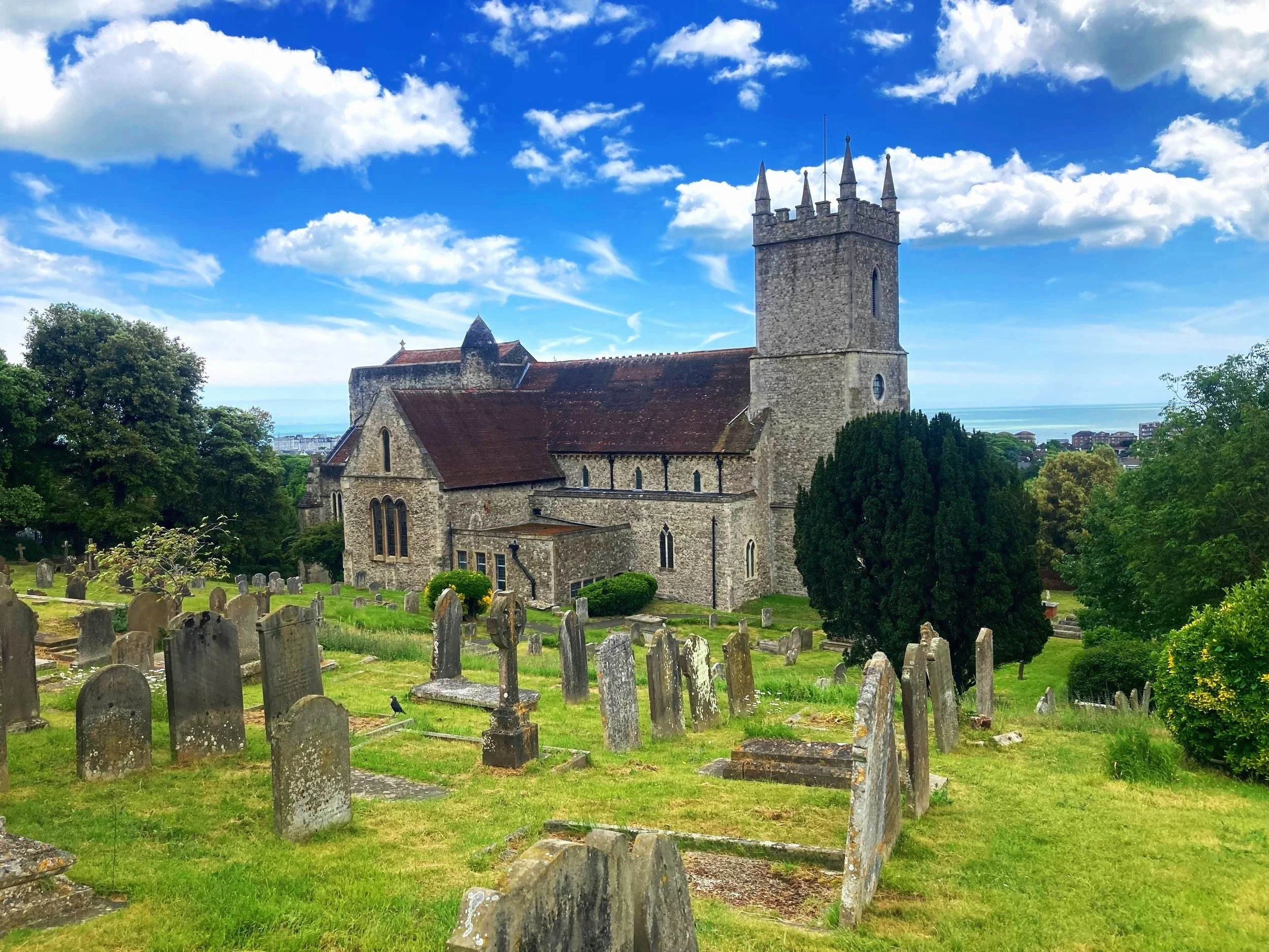The Ossuary at St Leonard’s Church, Hythe, England
Femurs and skulls at the Ossuary, St Leonard’s Church, Hythe
The Crypt at St Leonard’s Church
Thousands of human bones lie neatly arranged in stacks and on shelves beneath the floors of the church at St Leonards’ in Hythe, a small parish on the southeast coast of England. The ossuary holds the remains of about 2,000 individuals and is the largest collection of its kind in England. This charnel house or ‘bone-house’ as the ossuary is sometimes referred to, holds the remains of the de-fleshed dead.
A common practice in medieval times, charnel houses were used as repositories for bones that had been dug up to make room for new graves in overcrowded burial grounds. They were often found close to hospitals and religious sites and frequently built beneath medieval churches like the one at St Leonard's. The use of charnel houses in England dates back to about the 13th century and continued until the Reformation in the mid-16th century when the practice ceased, though they are still in use in many Catholic countries to this day.
St Leonard’s church which houses the ossuary, dates back to the year 1060 and was built by the Normans in the port town of Hythe, and may have incorporated an even older Anglo-Saxon place of worship into its foundations. The bones beneath the church were estimated to have been interred in the crypt during the 13th century and have largely remained undisturbed since then despite many people visiting the site over the years. The oldest documented sight-seer to the crypt was the town clerk of neighbouring Rye who wrote about an "orderly pile of dead men's bones" back in 1678. Now protected with a security system in place, a number of skulls have been stolen throughout the years, though one skull has since been returned. Taken by a heavy smoker in the 1960s, it was eventually returned after the perpetrator's death, stained yellow through years of nicotine exposure, and distinct from the other white-coloured skulls around it.
Skulls lined up in the ossuary at St Leonard’s crypt, Hythe
Reading the Dead; What the Bones Tell Us of the Past
What stories do the bones tell? Who were these people? And how did they live and die? While we don’t know for certain, it is thought that these remains most likely hail from the 13th century or earlier. Many theories exist as to how they ended up in the crypt in Hythe. One such theory suggests that the bones belong to dead Roman soldiers from the nearby Roman port, while another posits that they are from Vikings, killed in battle while invading England. Another popular theory is that the bones belong to the Anglo-Saxon soldiers who died in the nearby Battle of Hastings in 1066. Evidence however shows that these theories are unlikely, given that a high percentage of the remains are of women and juveniles with very few showing traumatic deaths and battle scars.
It is more likely that the bones belonged to the local people of Hythe, who were buried over many years in the churchyards of the area. When space was needed in these churchyards, the bones were dug up and interred in the charnel house beneath the church, where they have remained ever since.
What do the bones tell us about how they lived and died? Evidence of arthritis, broken bones, trepanations, cancers, and even head injuries can be seen, and like a lot of ancient bones, the remains found in the ossuary exhibit signs of general malnutrition. The term 'cribra orbitalia' is used to describe the porous bone that can be seen in affected skulls. It is thought to arise in people who suffer from general malnutrition, particularly iron deficiency anaemia, and also chronic infections. Given the swampy environment they lived in, malaria may have also been a factor for the high prevalence of cribra orbitalia among the skulls in the Hythe ossuary. Though their teeth were generally quite healthy due to the low-sugar diet of the times, there is also evidence of many dental abscesses and a general lack of dental care, which must have been excruciating for those affected.
Hopefully, with ongoing research being carried out on the bones at the site, we will learn more about who these people were and what their lives were like.
St Leonard’s Church and graveyard in Hythe
Top Tips
St Leonard’s Church is located in the quaint town of Hythe, along the South Kent Coast, about an hour's drive from central London. It’s also conveniently located near the seaside towns of Dover and Folkestone, making it an easy pitstop from either of these popular destinations.
The Crypt at St Leonard’s Church is located along the left-hand side of the Church via its own entrance. Just follow the signs for the crypt.
The ossuary itself is quite small and even with the short talk from the volunteer, it shouldn't take more than 20 minutes or so to see and read everything. Photos are allowed, but touching isn’t!
Admission is £5 for adults, £1 for children, and £10 for a family group of 2 adults plus one or more children aged 16 or under.
Opening times are limited to the spring and summer months. For 2025, this is from the 1st May - 30th September.
Mondays - Saturdays; 11am - 4pm (closed for lunch from 1pm-2pm) and Sundays; 2pm-4pm only.
I would suggest checking their website before visiting at https://www.slhk.org/theossuary.htm.
There is a small free parking lot just next to the church which is located at the following address; The Parish of St Leonard, Hythe, Oak Walk, Hythe. Kent, CT21 5DN


